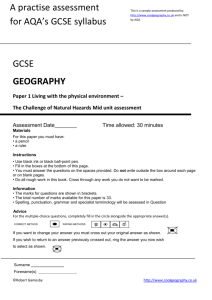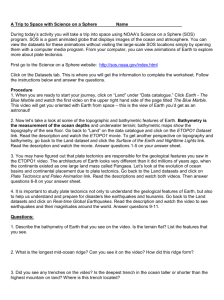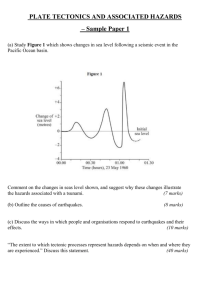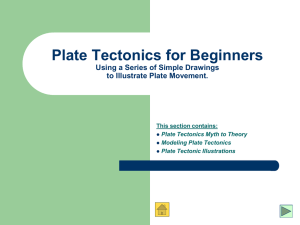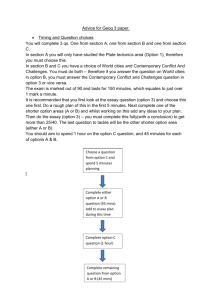File
advertisement
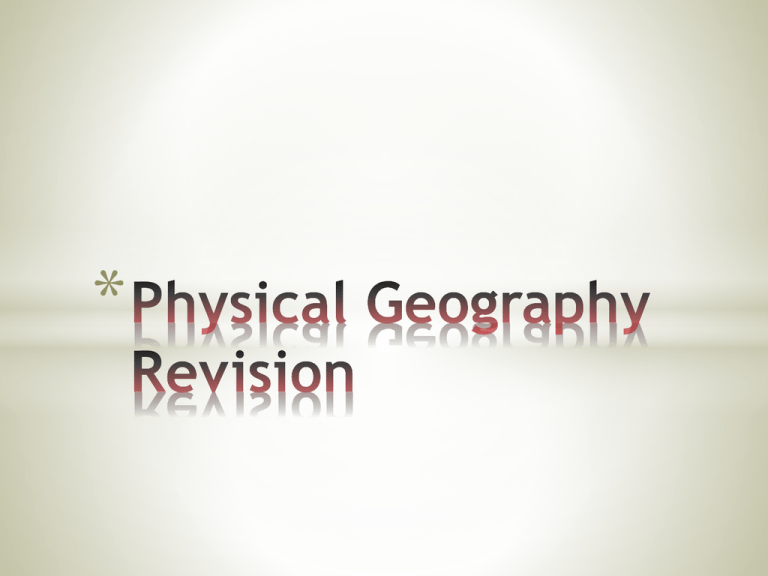
* Your physical revision needs to be divided into three parts: 1.The types of questions that appear as short questions 2.The study of landforms on the landscape 3.Human involvement/impacts/Use of… • Up to recently you were asked to describe the formation of a feature visible on the Irish landscape……….or to describe the surface processes involved in the creation of a feature you studied. • These were basically F.E.E.D answers. • However, it would be wise to note a change in question style. • You could be asked to identify a feature from a map first, give a grid reference and then describe how that feature was formed. • Simple right? • This is causing students to revise more than one or two f.e.e.d.s because you never know what type of map you will get. F.E.E.D’s to revise….. Plate tectonics: Earthquakes Volcanoes Fold Mountains Internal/External volcanic landforms Folding and faulting Glaciation: Cirque Moraines Drumlins Rivers: Waterfall Meanders and Oxbow lakes Deltas Coastal: Bays and Headlands Cave/Arch/Stack/Stump/Blowhole Beach Other physical topics to revise: Weathering (Physical, Chemical, Biotic) Mass Movement Rock types and landscapes (focus on limestone) Plate tectonics: 1. Explain how a study of plate tectonics helps us understand the occurrence of earthquakes…..or volcanoes…..or fold mountains. 2. Explain how the study of plate tectonics aids our understanding of the occurrence / global distribution of volcanoes or earthquakes 3. Summarise the positive and negative effects of volcanic activity. Refer to examples you have studied. 4. Examine the processes that have led to the formation of any intrusive and extrusive volcanic landform. 5. Examine with reference to actual examples, the measurement and effects of earthquakes. 6. “Plate boundaries are zones where crust is both created and destroyed.” Examine the above statement with reference to examples you have studied. Rock types / landscapes / weathering / mass movement: 1. With reference to the Irish landscape, examine the processes which have influenced the development of any landform in a karst region. 2. Examine how humans interact with the rock cycle in the case of oil / gas exploration 3. With reference to an example you have studied, describe and account for one way in which humans attempt to influence or control natural processes. In your answer refer to one of the following: Fluvial processes, Marine processes, Mass movement. 4. Weathering can be caused by physical or chemical action. Explain this statement, using one physical and one chemical process in detail. 5. Examine with reference to examples from Ireland, the formation of sedimentary rocks. 6. Examine with reference to an example you have studied, the formation of one rock type and how it produces a distinctive landscape. Glaciation, River, Coastal: 1. Examine, with reference to one of the following, how human activities can impact on surface processes: • Mass movement processes • River processes • Coastal processes 2. With reference to an example you have studied, describe and account for one way in which humans attempt to influence or control natural processes. In your answer refer to one of the following: • Fluvial processes • Marine processes • Mass movement 3. Effects of isostatic processes in the Irish landscape today. (Isostatic processes involve adjustments to the balance between land and sea. Discuss how these processes have shaped the Irish landscape over time.) 4. With the help of a labelled diagram or diagrams, examine the surface processes involved in forming one Irish landform. Honours level students: Ordinary level students: Answer ONE full Physical question. Answer ONE full Physical question. This will include an A, B, C part. This will include an A, B, C part. Questions 1-3=Physical Questions 1-3=Physical A: 20 marks (usually a sketch, skill, bar chart, matching details) A: 30 marks (usually a sketch, skill, bar chart, matching details) B: 30 marks : detailed answer B: 40 marks : detailed answer C: 30 marks: detailed answer C: 30 marks: detailed answer General revision should include: • Processes involved in each chapter of physical geography • Examples of features from each chapter • Names of events/dates/theorists • Recognise maps of plate boundaries, rock types, features etc • Check for commonly occuring long and short questions in your papers. • Remember what major physical events have occurred in the last year…..tsunamis, volcanic explosions, earthquakes etc etc,
